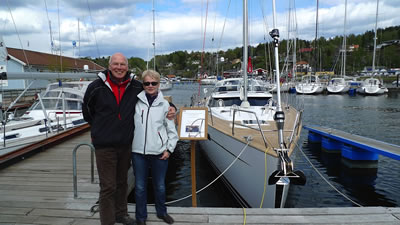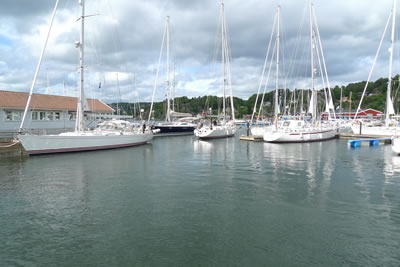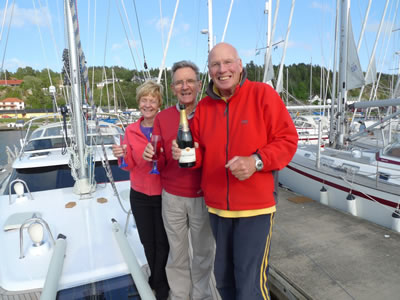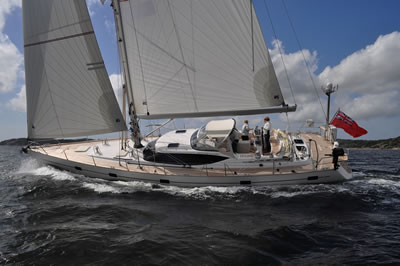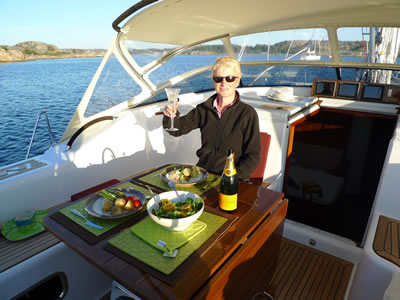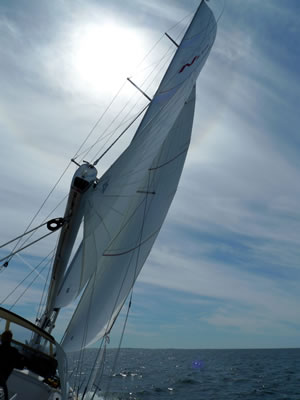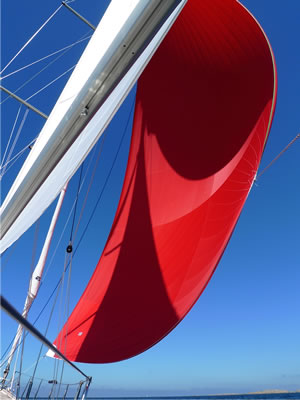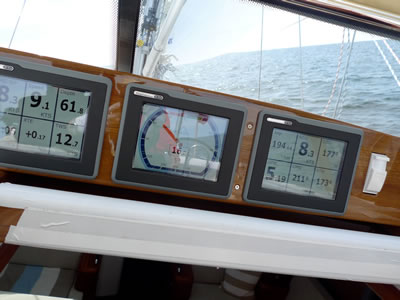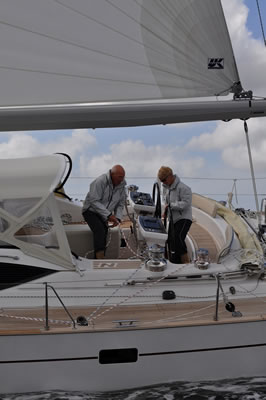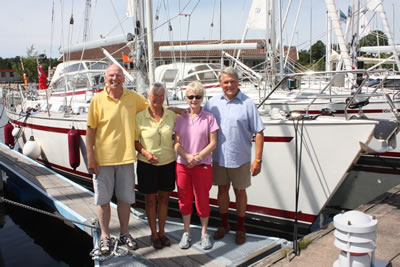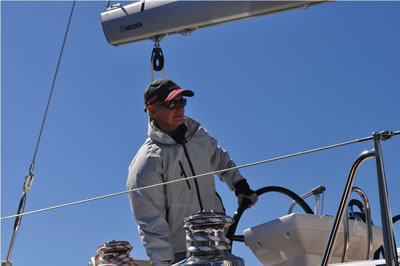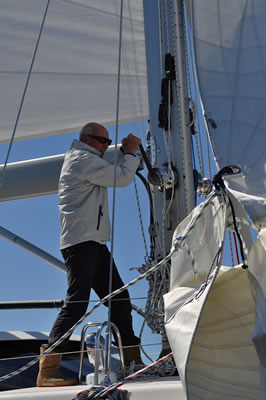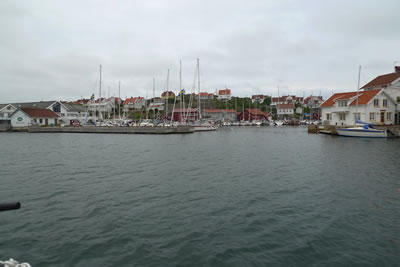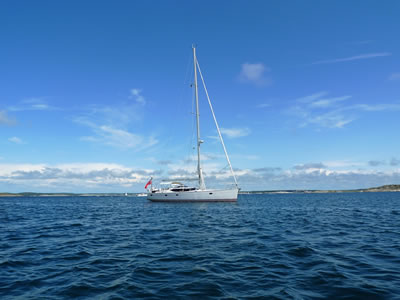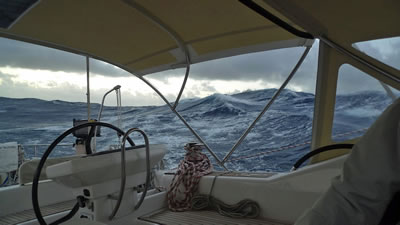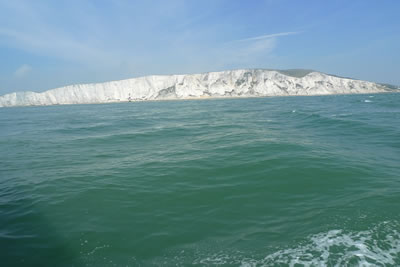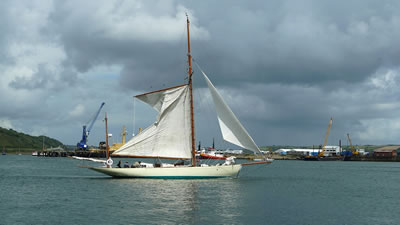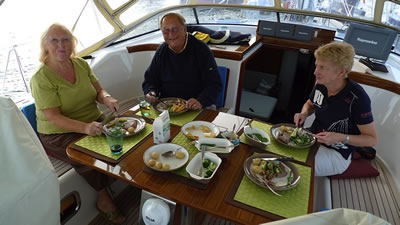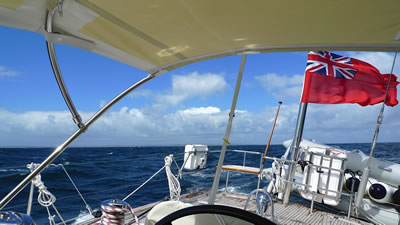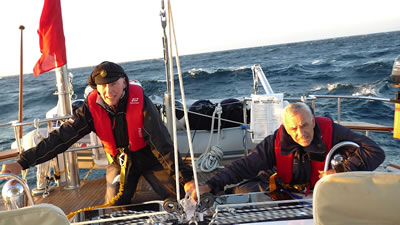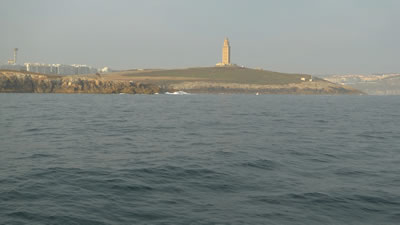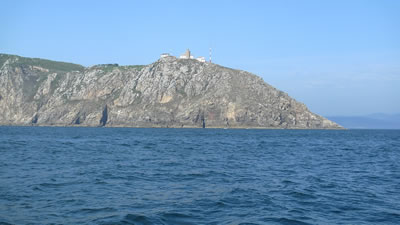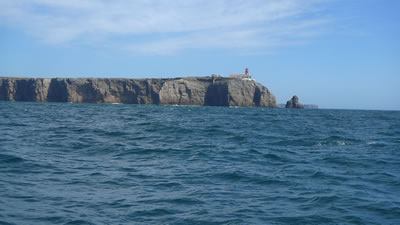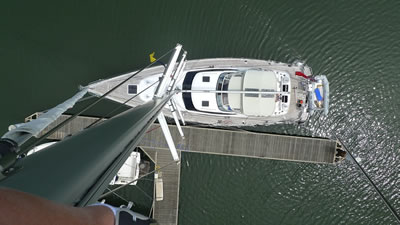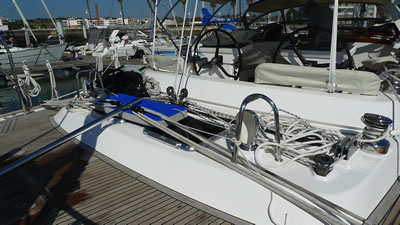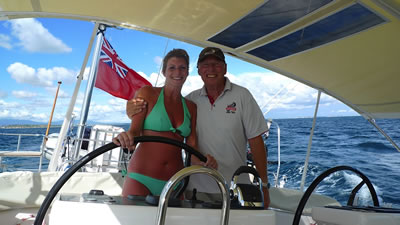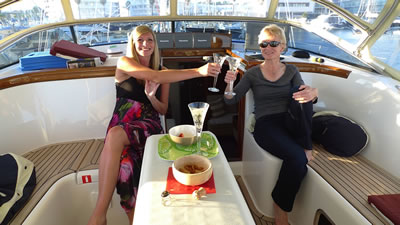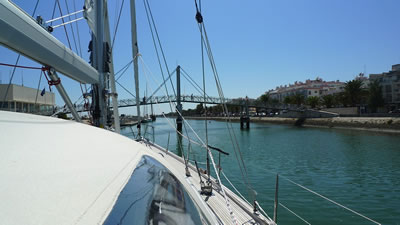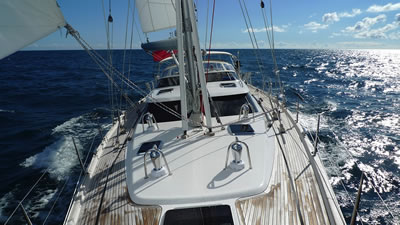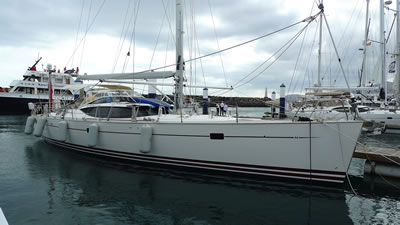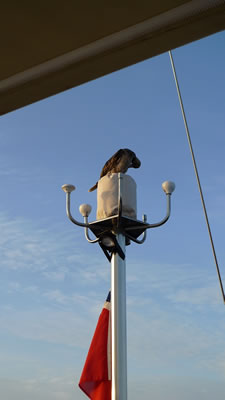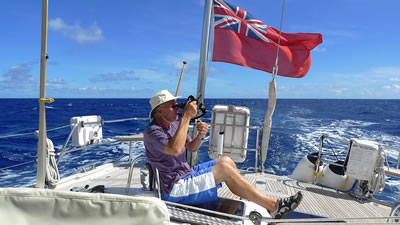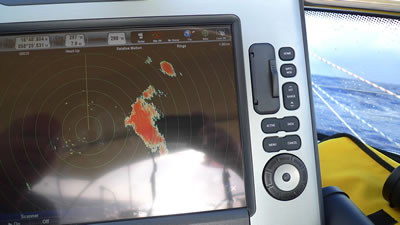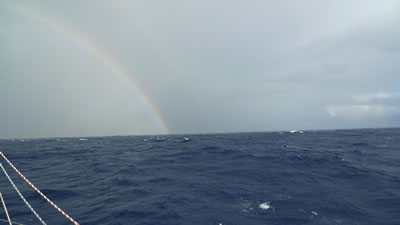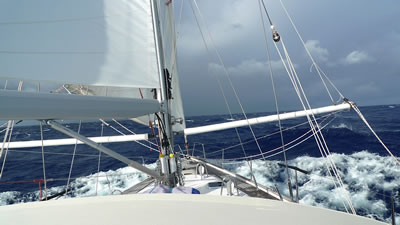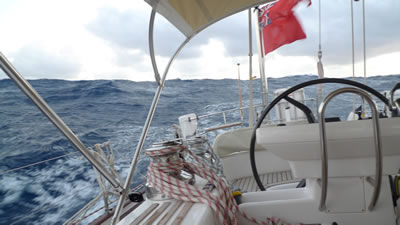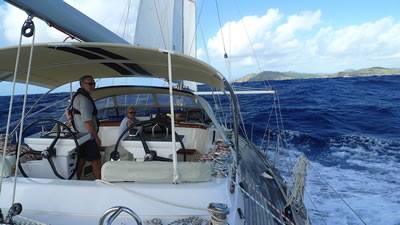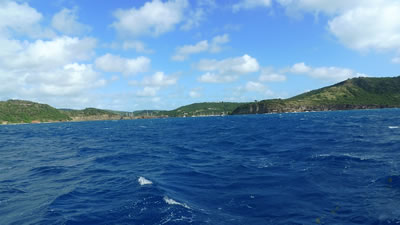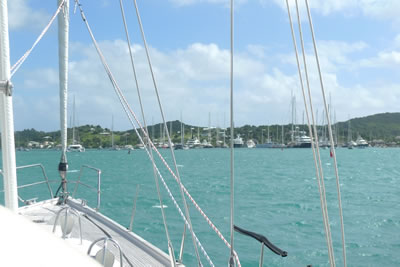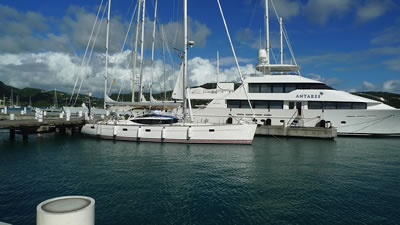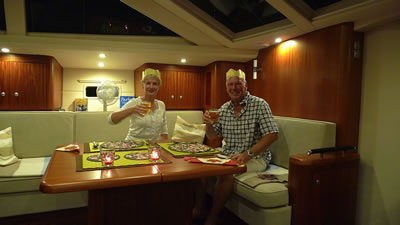Travel Log
Maiden Voyage 2011
(Sweden - UK - Antigua 2011)
Click here for photos of this voyage
 |
Inauguration day! Najad Marina, Henan |
Following an unusually cold, wet and windy Spring in Scandinavia, a weather window appeared on the day set some two months before our arrival in Sweden, to sail down to the Hamble. A passage of some 650 miles.
We slipped our lines in Henan, Sweden for the last time with strains of 'Sailing' by Rod Stewart wafting across the harbour on our external cockpit speakers. This has become something of a tradition with us when setting off on serious passages of which the North Sea is the most challenging due to the profusion of merchant ships, service vessels, fishing fleets, ferries and oil rigs. Add to this the sand banks, strong tides and shallow water and you have the perfect reason to sail elsewhere. However , we were on a delivery trip to the U.K. as a springboard to the Iberian peninsular and onwards to the Canary Islands.
In the late afternoon of the 1st July 2011, we motored down to Harmano Island taking us past the homes of Malo at Kungsviken and Hallberg Rassy at Ellos, wondering when we would next sail around the Swedish west coast. On passing Gullholmen we bade farewell to our first Najad (460), Song of the Sea tied up in the picturesque old fishing harbour. Our anchorage lay a mile further south on the east coast of the island on a perfectly tranquil summer's evening.
Next day at 0500, we weighed anchor in the forecasted NE wind and set sail for the northerly tip of Denmark, some 45 miles to our west. As the day progressed so the weather deteriorated necessitating a reef in the mainsail. We continued westward at full hull speed to make past the headlands of Hirtshals and Hanstholm. Our only concern was the dramatic decline in visibility along a leeshore off which there is one of the busiest shipping routes in the world. Surprisingly though, there is no Traffic Separation System. I suspect the Danish fisherman have a lot to answer for that.
Our A.I.S. transceiver came into its own and quickly claimed the prize for the most useful new toy. Jan, George and myself became dab hands at calling up the ships on M.M.S.I. giving us a level of comfort not experienced with previous yachts to the point where it worried us little that we were embroiled in a merchant shipping scrum.
 |
North Sea passage |
As the wind backed N and then NW increasing to 30 knots, we took more reefs in the main and shortened the jib on a pitch black night. The sea rolled over from Norway at 3 to 4 metres making for lively off watch conditions below decks. Jan and I, always ship a crew on longer passages as this enables us to break up the three hour watches with six hours off. The system usefully revolves forward around the clock for an equal distribution of watch times. Over the first 24 hours we covered 224 miles followed by a further 214 miles during the second. The N570 behaved impeccably with speeds of 10/11 knots through the water.
Once into sea area Thames our ride over the aggressive grey seas turned into blue skies and sunshine with a gentle summer's breeze. Rather than drift with the spring tide, we resorted to the whisper quiet 180 hp Volvo D4 to maintain our timing. The most notable issue was the wealth of commercial shipping streaming out of the English Channel and river Thames which kept us more than a little occupied on our A.I.S. transceiver. With the abundance of T.S.S. shipping lanes, the area seems to have more in common with the M25 motorway around London than the strains of 'Sailing By' that heralds B.B.C.'s Radio 4 shipping bulletin at midnight 0040 each morning.
The next major depression was forecasted for the British Isles on the evening of the 4th July and expected to sit over the country for the rest of that week. As this was to bring in severe SW gales with the accompanying seas over the spring tide, we were anxious to make Hamble Point Marina by that evening. We rounded the Goodwin Sands with the tide and then after fighting the new flood off Dover and Folkestone, took the ebb round Dungeness, Beachy Head, Selsey Bill and on into the Solent. We completed the 650 miles passage in 3 days and thirteen hours. George who has undertaken this trip many times in all seasons over the last 25 years delivering new Swedish yachts to the U.K. and beyond, said that it was the fastest crossing he had ever made.
We slipped our lines in Hamble Point marina at 0800 on the 26th July for Falmouth. Jan's nephew Andrew who had just graduated from Nottingham University, accompanied us for the 180 miles passage which in addition to the experience, enabled him to visit his girlfriend in the West Country.
The twenty miles down the Solent to the Needle's was with the tide under motor. On crossing Poole Bay however , we picked up a useful NW 3 which was all that was required to speed us on at 6 to 7 knots to Portland Bill under mainsail and jib. On crossing Lyme Bay the wind deserted us for the night to necessitate the re-introduction of the motor but returned at daylight to give us a fine reach from Start Point to our berh at Pendennis marina.
 |
S/Y Patna re-rigged as a gaff rigged yawl |
Falmouth is a favourite watering hole of ours with lovely Cornish scenery, good walks and adequate facilities. Jan and I, took time to visit my father's old boat Patna at Frenchman's Quay, Helford where she has been painstakingly restored as a gaff rigged yawl. She was originally built in c1920 as a gaff rigged cutter to compete at club level with the 12 metre class. My father sailed her from c1951 through c1972 as a bermuda cutter. Yachting World once described her as the prettiest little yacht Camper & Nicholson ever built.
The weather became unsettled with a succession of Atlantic depressions driving into the British Isles. We identified a weather window on the 8th August and slipped our lines at 1300 in a NW 6 for La Coruna, Spain some 450M to the south. This necessitated our reefing the mainsail and jib in a lively sea. By nightfall, Lizard Point the most southerly point of England, had long since dipped below the horizon and we were making to pass west of the Ushant TSS.
Once south of Britanny, conditions turned quite rough with 30 knots out of the west / north west. One particular rogue tumbled down the foredeck over the deck saloon and spray hood to douse the unfortunate on watch crew, David Prior. However, by dawn the seas had subsided to give us a gentle NW 4 reach across the Bay of Biscay. On closing the Spanish coast the wind steadily built again to 30 knots with 4 metre seas. Our minds were already dwelling on paella and rioca wine when we were suddenly brought to our senses by a sickening bang from the poop deck followed by the boat rounding up sharply to weather. My first concern was to check for any ingress of water. Below decks, Jan discovered the drag link between rudder post and reduction gear box had buckled and come adrift.
 |
Approaching La Coruna after 25 miles & 7 hours under emergency tiller |
David made an immediate suggestion to hove-to which was good advice. Quite often modern hull designs do not take well to hoving-to, but to my relief this was not the case with the Najad 570. This allowed us to attach the emergency tiller a somewhat basic arrangement, with great difficulty. On reaching into the lazarette locker to retrieve this unwieldy piece of armory, a wave rolled down the weather deck and inflated my life jacket. There I was upside down five feet below decks with just my feet waving in the wind, stuck as in some comedy film feature. However it's amazing what strength one can muster when in a jam and inch by inch I forced myself back through the narrow hatch. David and I, painstakingly steered the remaining 25 miles clinging on to the poop deck, into La Corruna estuary and anchored off the beach at Ares at midnight 0030. The 25M since we were struck by the incident had taken a harrowing 7 hours. I suspect that many 'yotties' like myself, have looked upon the emergency tiller as a bit of a box ticking exercise but let me say that after this experience, it has commanded my total attention. I now have a four to one block and tackle permanently rigged so that if the occasion arises again, all I have to do is pluck the tiller unimpeded, out of the lazarette attach it to the rudder stock and double block shackles with the lines returning to the cockpit winches. A manoeuvre that will take no more than 5 minutes.
I have to say that Lewmar turned up trumps in resolving our problem and on taking the boat into La Corunna marina next day, they quickly had their local agent replace the wayward drag link. This was the first time I had been to La Corunna and what a pleasant experience it turned out to be. Firstly the new marina is an absolute dream to stay in. The staff are delightfully hospitable and helpful. Secondly the city is full of historic interest and culture with great facilities. If you haven't been then I would recommend you try it when next in the vicinity.
 |
Lady Captain |
Our next port of call was Mueros just south of Cape Finisterre. The wind was unhelpfully light and certainly not powerful enough to make any sense of the considerable swell that was rolling in from the Atlantic. Having bade our farewells to David, Jan and I, spent the most part motor sailing the 10 hours and 80M to anchor off the pretty, small town and fishing harbour. Despite the tranquil description though, we had to suffer an outdoor local band playing unsociably loud pop music until 3 am in the morning. We could have done without it really!
Next port of call was Bayona with which I have a personal issue. We sailed in light easterly winds and poor visibility under mainsail and jib over the 45M. A new discovery was the automatic fog signalling facility on our Raymarine VHF, it never ceases to amaze me how technology has move on over the past 10 years and three boats. We eventually dropped our anchor on a peaceful night off the town with a view to getting underway at first light for Cascais, Portugal.
The 215M to Cascais was to take us a day and a half. We got underway at 0600 with the breaking dawn. The wind was NW3 which enabled us to set the Simbo Rig and have a very leisurely run down the coast under blue skies and sunshine. What a change to c2005 when there were out of control forest fires raging all the way down the coast driving plumes of sickly wood burning fumes and land birds out to sea. However, conditions this year were blessedly normal and with Jan and I, doing 3 hour watches the time passed quite peacefully until that was, we had to negotiate our way through the minefield of illegal lobster pots off Cascais harbour when in 20 knots of wind, our inmast furling mainsail refused to furl. This neccessitated Jan and I, having to drop our vertical battened mainsail on deck in less than desirable circumstances and lash the sail along the boom before entering harbour. Oh, the joys of sailing!
Selden was very good in arranging for their agent to come and look at the problem. The trouble was that he had no experience of hydraulic furling so we thanked him for coming and bade him farewell. We then set about analysing the problem. This turned out to be the locking pin between foil and hydraulic motor which to my amazement is only secured with Loktite, had worked loose and prevented the foil from revolving. How pleased were we that we hadn't taken in a reef during the passage!
The ever helpful Selden then put us in contact with Peter Keeping, their man in Lagos. He is an Englishman who is held in high esteem in the Algarve for his rigging services. However, as he was on holiday we agreed to sail the boat south to Lagos by the following Monday morning when he would pay us a call. This was en route in any event although, we were disappointed in not being able to spend longer in Cascais and Estoril. In fact the whole of the Lisbon province is delightful and as for the Portuguese, they just have to be our favourite Europeans.
The passage down to Sines of some 55M was undertaken in a NW6 which was perfect for our poled out jibs. In fact we had no need for a mainsail as we sped along at 9 knots. However, what was disconcerting was the development of a worrying metallic clanking sound from our reduction gear box as the autopilot struggled with the 3 metre following seas. We recorded it on dictaphone for later analyses.
 |
Cape St Vincent |
A quiet night anchored in Sines Bay was followed by an early start for Cape St Vincent and onwards to Lagos. Our twin jibs worked fine to start with in a NW3 but then had to be replaced by the motor in an ever decreasing breeze. Once round the Cape and Henry the Navigator's museum at Sagres, we picked up a useful afternoon wind of the land to complete the 77M passage to Lagos under sail.
Peter, Keeping appeared at noon next day armed with an entirely new fitting from Selden with a s/s welded nylock nut to secure the locking pin. It took 7 hours to release the hydraulic motor from the mast to gain access to the offending part and 5 minutes to fit the new locking pin! Najad also arranged for one of their shipwrights to correct some woodwork and last but not least, the ever dependable Lewmar despatched their specialist from England to replace the reduction gear box and overhaul our entire steering system. All very satisfactory.
We enjoyed Lagos greatly. It is an attractive town with excellent facilities, in fact one of our favourite restaurants in the world is located there, Artistas. Just ninety kilometres away there is a good international airport with excellent connections. To cap all this, our daughter Lorna, came out for a week's holiday which made it a memorable stay.
 |
Dad & Daughter, The Algarve |
Following her departure we slipped our lines for Puerto Calero, Lanzarote some 660M to the south in the Canary Islands. We set off with a strong wind out of the north under Simbo Rig making good time over the first 24 hours. Thereafter the wind slowly subsided so that by the third day we were down to motoring. The further south we ventured the more we lost the influence of Hurricane Katia's long range affect on the ocean which began by greeting us with a 4 metre swell round Cape St Vincent.
On our arrival after three and a half days at sea, at what has to be one of the nicest marinas to be found, we were allocated a super yacht berth. This was perfect as we intended leaving Song of the Ocean there until early December when we planned to slip our lines for Barbados and the Caribbean. The marina is very clean and as is well documented, even the brass bollards around the quay are polished every day. Unlike most other marinas that we visit, there are excellent restaurants around the private harbour plus all the necessary yachting facilities including a 90 tons hoist. If you need to tour the island then a mere 50 Euros will hire a car for two days inclusive of full insurance cover. Finally the international airport is just 10 minutes up the road. Perfect.
We returned to Puerto Calero on the 24th November. During our two month absence Charlotte Gilpin a local English DJ, had looked after SotO, washing her down each week and updating us with comprehensive email reports. We were introduced to her by the local boatyard and I would thoroughly recommend her services to any interested party.
The weather had turned cool and unsettled. We had hoped to slip our lines on the 1st December but deferred to the 4th to allow a weather system to pass through. The trip was to prove unusual in so far as a huge area of stationary high pressure stretching from the Azores to America trapped low pressure below it which frustratingly wiped out the trade winds for the whole passage.
 |
Atlantic noonsite |
We sailed down the coast of Africa in strong NW winds to pass through Cape Verde between the islands of Sal and St Nicholas. Matters of interest en route were a boobie bird which took up residence on our Fleet 250 ariel dome for twelve hours, an accidental gybe whilst gybing the main in big seas which damaged the car on the mainsheet traveller and the infernal social chatter from the local Africans on channel 16 covering anything from jokes to pop music and something resembling tribal war cries. I pondered on whether I could recall any piracy on the west coast of Africa recently, half expecting an un-welcomed visitation in the dead of night.
Not until we were down to 15 degrees N could we find any east in the wind to set course for the West Indies although the butter was still nowhere near melting! Nevertheless despite the lack of trade winds with their puffy white clouds, the north/north easterlies which were to set the scene for the crossing were at least a step in the right direction. The moon proved a good companion, waxing during the first part and slowly waning over the second. I was able to make good with my celestial navigation. I have a WW2 ex u-boat sextant made by C. Plath which an uncle of mine had acquired in Cuxhaven after the war. I have treasured it ever since and have put it to good use on our several Atlantic crossings.
 |
Approaching Antigua, George and Jan |
As with most of these previous transatlantics Jan and I, were accompanied by our old shipmate George Malony which gave us the comfort of working three hours on watch and six hours off. It's also a safer option in handling the unexpected, like man overboard, rig or rudder failure and heavy weather. On this occasion strong wind and big seas were to be our main contender as we skirted below a succession of low pressure systems. The winds were to be irritatingly on the cusp of broad reaching and running. I had so much looked forward to running down wind under the Simbo Rig for a couple of thousand miles but this was not to be.
Nevertheless, we completed our protracted passage of 3288 miles to Falmouth Harbour, Antigua in 18 days albeit by the scenic route. It wasn't the best crossing we've ever made let alone the fastest but we were pleased to have been able to return George to Old Blighty on Christmas Eve for his family's festivities. Just!
Click on any photo to start the slide show or view larger versions
